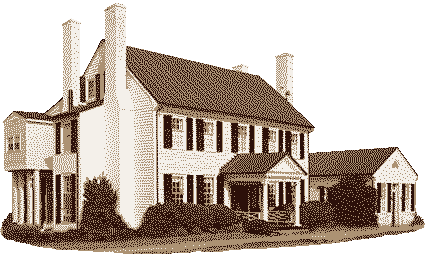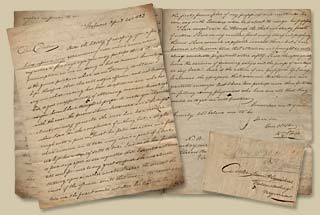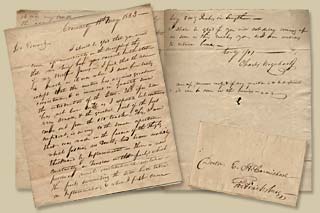Letters to Doctor James Carmichael & Son
Historical Collections at the Claude Moore Health Sciences Library, University of Virginia
IMPORTANT: Please upgrade your browser to view this site as intended.
Site Navigation
Path to Current Page

- Dr. Carmichael’s house, now a private residence, still stands on Hanover Street in Fredericksburg, Virginia. Dr. Carmichael & Son's office was adjacent (seen here on the right).
James Carmichael (1771-1831) was born in Glasgow, Scotland and was brought to Fredericksburg, Virginia at an early age by his uncle, Dr. George French.
French, a prominent doctor and mayor of Fredericksburg for several terms, raised Carmichael. When Carmichael was of age, French sent him to Edinburgh to study medicine. Upon completion of his medical education at the age of 20, Carmichael returned to America and began his own medical practice in the growing and relatively prosperous town of Fredericksburg. After relocating his business to several different offices in town, Carmichael eventually settled on opening a small brick office adjacent to his home. He soon became a busy and well-regarded physician in Fredericksburg and the surrounding countryside.
Carmichael quickly assimilated himself into Southern culture, becoming a slave owner and eventually owning twelve slaves by 1820. In June 1794 Carmichael married Elizabeth Hackley and together they had six children. Two of the boys joined their father in his medical practice. In advertisements placed in the local newspapers, Edward was announced as joining his fatherís practice in May 1817 and George joined eleven years later in May 1828. Thus began four generations of Carmichaels who practiced medicine in Fredericksburg.
The letters writtten by patients to James Carmichael indicate that his medical expertise and skills were trusted, but they reveal little about his personality. However, by examining a few of the second–hand sources about him, James Carmichael indeed appears to have been a colorful character. In one recollection, he played a practical joke in the Methodist church located across the street from his house. He and a fellow conspirator sprinkled snuff over the heads of the congregation causing the members to break out in fits of sneezing. For this, Carmichael and his friend spent the night in jail. [Source] His eccentricities are further elaborated upon in a 1937 WPA survey report about the Carmichael house. The interviewer related that Carmichael generally abstained from alcohol, and yet at “long intervals, often more than six months apart, he got into what was called a ‘spree’.” During this drinking bout, which could last anywhere from several days to a week, Carmichael engaged in peculiar—even criminal—behavior such as breaking and entering into his patients’ homes. While he was in this inebriated state, other doctors in town carefully attended to his patients. [Source]
Despite his occasional unconventional behavior, Carmichael remained a beloved physician in the community. When he died at the age of 60 in 1831, his published obituaries were very favorable. The obituary in the Virginia Herald stated, “Few men of the Faculty have had a wider range or been more successful as a practitioner of the healing art—He was justly regarded as very skllful[sic] and had the highest confidence of the community in which he lived and died.”[Source] The Political Arena’s obituary was more glowing:
The loss of such an individual is no common calamity. Eminently skilled in complicated duties of his profession, he acquired the unlimited confidence of his numerous patients. Philanthropic and benevolent in disposition, he possessed their love, for where strength and heart failed and human aid could avail nothing, while his skill softened the stroke which it could avail nothing, while his skill softened the stroke which it could not avert, his sympathies soothed the agonies of surviving affection, and by pouring oil and wine into its wounds, assuaged at least what he could not heal. It is not only therefore in the sacred privacy of his domestic circle, that his loss will be felt in all the bitterness of unavailing sorrow, but the afflicted tenant of the bed of sickness—aye, even the hopeless despondency of the chamber of death, will mourn over the loss of that skill, to which infirmity looked for relief, and that consolation which would have smoothed the pillow of departing mortality. [Source]

- William Fife inquired of Edward Carmichael whether he, in his practice or in his reading, had ever heard of a person being a “half-man, half-woman.” (April 26, 1823)

- Charles Urquhart writes to Carmichael about performing an operation on an ulcer located on his brother’s thigh. (May 15, 1823)
Letters in the Carmichael Collection detailing the medical practice of James, Edward, and George Carmichael cover a span of eleven years. During these years, the doctors encountered a wide array of medical conditions in their numerous patients. Worms, malaria, dropsy, dysentery, venereal disease, rheumatism, and bowel complaints are a few of the more frequent ailments plaguing their clients. However, there are also letters that contain examples of cases that were not so ordinary. Because the Carmichaels were so well-regarded in the medical community, and many individuals had obtained medical experience by training under the Carmichael’s tutelage, physicians wrote to them seeking their advice on particularly difficult cases. In 1823, William Fife, a practicing physician in Gloucester County, sought the expertise of Edward Carmichael. Fife turned to Carmichael because he knew no other individual whose “reading has been so extinsive[sic] and who had so good an oppertunity[sic] of obtaining medical knowledge as you have.” Fife was puzzled by the case of a 70 year-old woman he examined following her death. He learned that she was “half-man, half-woman” and depicted his findings in some detail. In another letter, Dr. Charles Urquhart vividly described an ulcer on the thigh of his brother James. Urquhart suggested an operation on James’s leg and ended his letter by requesting that Carmichael “come prepared with all the Instruments necessary to act.”
Next: The Pharmacy of Doct. James Carmichael & Son
© 2019, Rector and Visitors of the University of Virginia
Historical Collections and Services at the Claude Moore Health Sciences Library